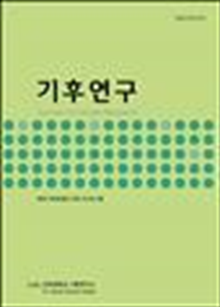간행물
기후연구 KCI 등재 Journal of Climate Research

- 발행기관 건국대학교 기후연구소
- 자료유형 학술지
- 간기 계간
- ISSN 1975-6151 (Print)2288-8772 (Online)
- 수록기간 2006 ~ 2021
- 주제분류 사회과학 > 지리학 사회과학 분류의 다른 간행물
- 십진분류KDC 453DDC 551
권호리스트/논문검색
제10권 제1호 (2015년 3월) 5건
1.
2015.03
서비스 종료(열람 제한)
Change of weather disaster having occurred in Korea since 1960s was analyzed using newspaper articles recording objective facts and reflecting consciousness of the times. The analysis was carried out on 6 disasters: heavy rainfall, cold wave, heavy snowfall, typhoon, heat wave and drought. To focus on the events having great social impacts, articles were chosen among top articles on the front page and general page of the newspapers. Dong-A Daily News articles were sampled from 1960 to 2013, for 54 years. A total of 315 articles were analyzed, among which typhoon accounted for the largest proportion of 36%. Heavy rainfall, heavy snowfall, drought and cold wave followed typhoon, and the topics of heat wave accounted for the lowest percentage of 6%. Articles of typhoon and heavy rainfall accounted for 57%, which is more than half of all. Drought and cold wave are concentrated in the 60s to 70s, and heavy snowfall and heat wave have sharply increased since 2010, due to the tendency of global warming. Articles have decreased over time because the importance of those articles has declined as a result of social development.
2.
2015.03
서비스 종료(열람 제한)
The necessity of climate change adaptation has steadily increased due to the increasing meteorological disasters. The authority supports the vulnerability assessment tools for tuning the local governments’ countermeasure. However, the results by the vulnerability assessment tools have not been clear enough. The current study aims to collect and analyse a variety of raw data for proving the unclear assessments. The paper identifies climate change-vulnerable areas by overlapping the modified results and pervious results. The climate change-vulnerable areas included the regions having high impacts on meteorological disasters.
In a nutshell, the paper contributes to the identification of the vulnerable areas for the local government’s planning the provision against climate change. The local governments are obliged to establish the climate change action plan by 2015. The results of the current paper would help providing reliable data and planning the countermeasure against climate change. Korea is exposed to the climate change vulnerability such as increasing elderly population, high density of urban areas. In order to respond the climate change vulnerability efficiently, this study potentially suggests a primary research method for resolving the climate change vulnerability.
3.
2015.03
서비스 종료(열람 제한)
Centennial- to millennial-scale climate change since the last glacial needs to be revealed to improve the overall predictability of future environmental change. Special attention has been paid to short-term climate oscillations because they usually occurred rapidly enough to cause noticeable change in the average expected lifespan of human. Recently, short-term climate change during the late last glacial was successfully reconstructed from Hanon maar paleolake in Jeju island. In this study, centennial- to millennial-scale climate signals transferred via atmospheric teleconnection were detected for the first time in South Korea. Possible future presence of abrupt climate shifts such as Younger Dryas or 8.2 ka event would not seriously influence the Korean peninsula, especially not Jeju island, due to the Kuroshio warm currents. The study of climate variabilities in Korea could provide essential paleoclimatic information for the entire East Asian monsoon region since the climate of the Korean peninsula is driven significantly by coupled land-atmosphere-ocean dynamics.
4.
2015.03
서비스 종료(열람 제한)
The COMS (Communication, Ocean and Meteorological Satellite) has been used in numerical weather prediction and meteorological monitoring over East Asia and Oceania since it has been launched in 2010. For more active utilization in climate research, the COMS level 3 products should be available in appropriate spatial and temporal resolutions. We compared different methods to generate monthly sea surface temperature (SST) products from the COMS time-series data. We employed three techniques for aggregating the time series, which are arithmetic mean, timeslot average, and moving average, and also used mean ensemble of them. Each level 3 dataset around South Korea was compared with monthly SST product from the Moderate Resolution Imaging Spectroradiometer (MODIS) of Aqua satellite during April 2011-March 2014. The timeslot average showed better root mean squared difference (RMSD) during the initial operational period of the COMS, when the retrieved values could be somewhat unstable. Daytime aggregations were derived more accurately by using the arithmetic mean or moving average, and the accuracy of nighttime aggregation was improved by the mean ensemble. Also, the timeslot average presented reasonable results particularly for coastlines where the standard deviation and missing value ratio were greater than normal. Because an optimal aggregation technique was variable depending on spatial and temporal conditions, we should be careful in selecting appropriate method for generation of the COMS level 3 products according to research objectives.
5.
2015.03
서비스 종료(열람 제한)
This study investigates the direct and indirect effects of anthropogenic aerosols emission on East Asian climate during the winter (December-February) for the period of 1961-1990. Using a globally coupled climate model, HadGEM2-AO, we compare ensemble means between historical runs with and without aerosol emissions. During the 20th century the major contributions to the total Aerosol Optical Depth (AOD) over the East Asian region came more from anthropogenic aerosols than from natural aerosols. The increasing total AOD induces the negative radiative in a clear-sky condition, leading to cooling the surface. Indirect effect contributes to the increase in the total cloud fraction, resulting from the increased low-level stratus and stratocumulus clouds. Consequently, the net surface radiative flux becomes negative due to the direct and indirect effects of aerosols. Land surface cooling seems to enhance the landsea pressure gradient in the East Asian wintertime climate, and the associated wind anomalies induce the regional wintertime precipitation amount changes over South China.

